Shared Services Canada Overview
Purpose
The purpose of this departmental overview presentation is to:
- Describe Shared Services Canada and the role of the Minister responsible for Shared Services Canada.
- Outline the department’s priorities, structure, and regional distribution.
Shared Services Canada at a Glance
Shared Services Canada has a mandate to modernize and consolidate the federal government’s information technology infrastructure, including email, data centres, network and end‐user devices.
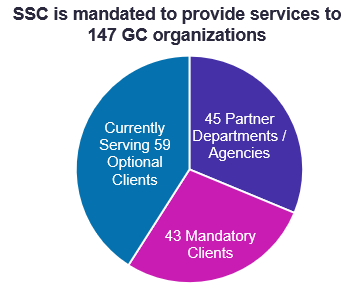
Text description – Clients and partners
- 59 Optional Clients
- 45 Partner Departments/ Agencies
- 43 Mandatory Clients
Services
Shared Services Canada provides a full range of shared information management and information technology services to 45 mandated partner departments/agencies (including Shared Services Canada itself), and a subset of those services to all other customer Government of Canada departments and agencies
(see annex for specific organizations)
Cyber Security
Shared Services Canada supports information management and information technology security in partnership with Communications Security Establishment Canada, including the Canadian Centre for Cyber Security, and other partners.
Shared Services Canada supports a disparate portfolio and is working to reduce/consolidate the number of systems
50 Networks
21 Email Systems
385 Data Centres
12, 000 Government of Canada Applications
SSC and the Development of the GC IT Portfolio
2011
- SSC was created to integrate the GC IT infrastructure and some IT support services (email, telecommunications).
- SSC took over an aging patchwork of IT systems and networks that were created independently of each other and lacked interoperability.
- Early work involved consolidating and maintaining the newly designated SSC IT infrastructure.
- Once that was done the Department prioritized improving service delivery.
2019
- GC supported significant investments in digital services under the strategic direction of SSC 3.0 – an Enterprise model.
- SSC has made progress repairing and replacing critical hardware infrastructure, including:
- decommissioning costly legacy data centres.
- Implementing modern cross-government information technology solutions.
- Progress to support departments to modernize their applications has been slower.
COVID-19 Response
- COVID-19 highlighted the critical role of SSC in the delivery of federal services. The pandemic accelerated SSC 3.0 rollout which resulted in:
- Network and Security upgrades leading to new services
- Migration to Cloud-based hosting solutions to ensure capacity and reliability
- Onboarding departments to MS Teams and a general standardization of Enterprise Applications across GC.
- Improving SSC priority setting practices
SSC has worked to address the ‘technical debt’ that resulted from decades of under-investment as information technology infrastructure ages faster than the pace of repairs or replacements.
Older infrastructure is costly to maintain, performs poorly, and can be more prone to service interruptions.
Aligning Priorities Across Horizons
SSC is a service delivery organization that must balance meeting the needs of clients today while ensuring that the organization is prepared to respond to the challenges of tomorrow.
Digital Landscape
Key Federal Departments
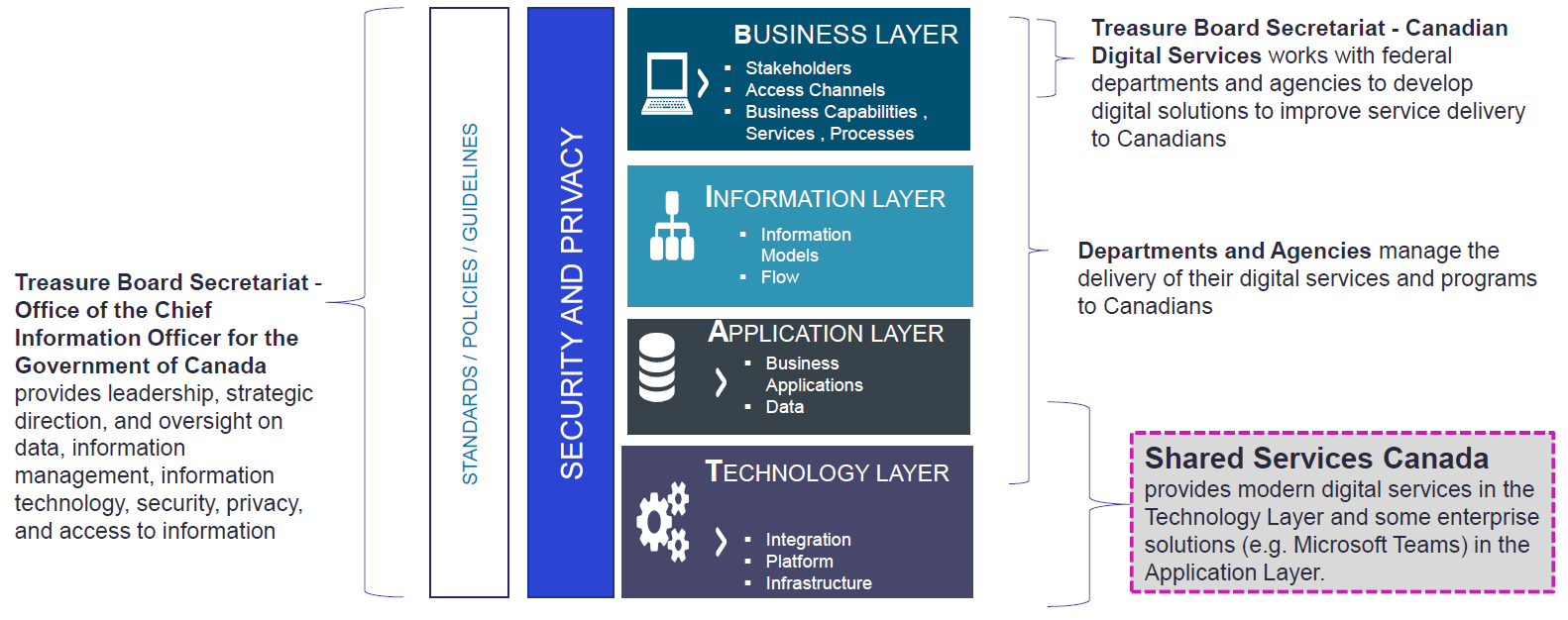 Click to enlarge
Click to enlarge
Image description – Key Federal Departments
The Government’s Digital Landscape involves key organizations playing roles in four separate layers. These are the business layer, information layer, application layer and technology layer (BIAT). The Treasury Board Secretariat (TBS) Office of the Chief Information Officer (OCIO) provides leadership, strategic direction and oversight on data, information management, information technology, security, privacy and access to information across the layers.
The business layer contains stakeholders, access channels, business capabilities, services and processes.
The information layer contains information models and flow.
The application layer contains business applications and data.
The technology layer contains integration, platform and infrastructure.
In the business layer, TBS and the Canadian Digital Services work with departments and agencies to improve service and program delivery to Canadians., and the departments and agencies in question who manage and deliver the services and program to Canadians.
The role of departments and agencies who manage the delivery of their digital services and programs to Canadians spans BIAT.
Shared Services Canada’s role focuses on the application and technology layers given its mandate to provide modern digital services and some enterprise solutions to departments and agencies.
Other Federal Partners
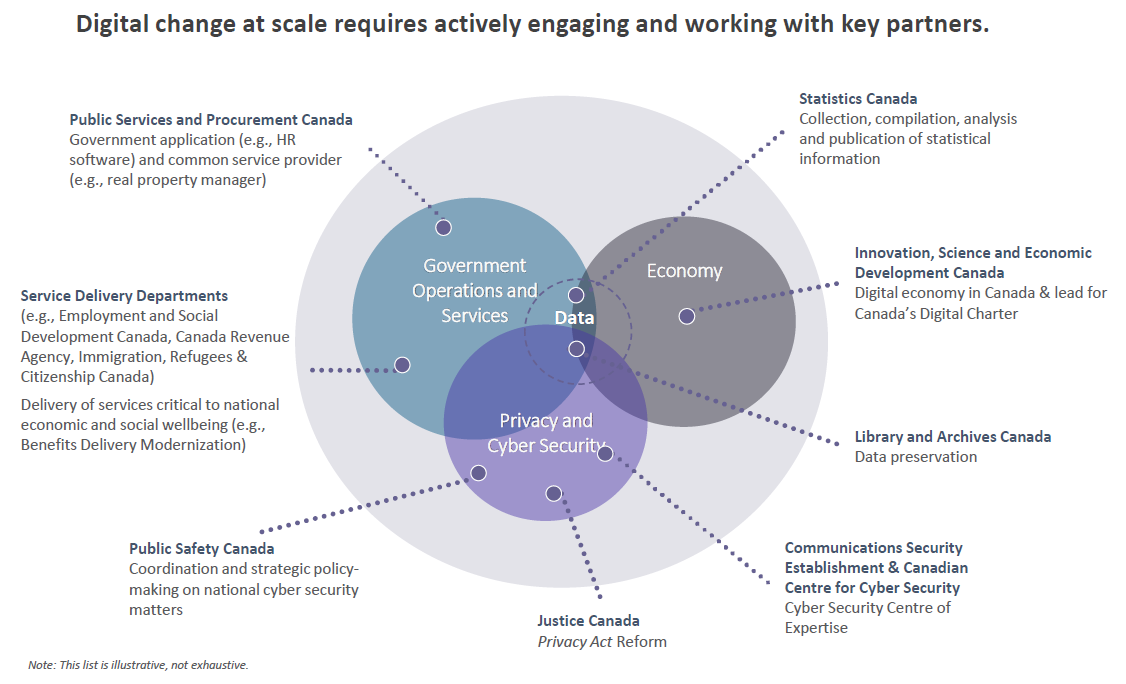 Click to enlarge
Click to enlarge
Image description – Other Federal Partners
This Venn diagram shows the overlapping aspects among the federal organizations actively engaged in digital change at scale. The four circles in the diagram are (1) Government Operation and Services, (2) Privacy and Cyber Security, (3) Economy and (4) Data.
Government Operations and Services includes Public Services and Procurement Canada and the other service delivery departments (e.g. Employment and Social Development Canada, Canada Revenue Agency, and Immigration, Refugees and Citizenship Canada). Their work involves government applications and delivering critical national economic and social well-being services.
Privacy and Cyber Security includes Public Safety Canada, Justice Canada, the Communications Security Establishment (CSE) and the Canadian Centre for Cyber Security. They coordinate and make strategic policy on national cyber security matters (Public Safety), Privacy Act reform (Justice Canada), and cyber expertise (CSE and Cyber Centre).
Economy includes Innovation, Science and Economic Development Canada, which leads Canada’s digital economy and charter.
Data includes Statistics Canada and Library and Archives Canada who collect, compile, analyze and publish statistical information and preserve data.
Shared Services Canada by the Numbers
SSC is committed to improving information technology service delivery and management and is constantly evolving its service management practices and processes across the organization, with the goal of delivering service excellence to its customers
SSC Financials
- $3.2 billion Total Expenditures (and trend has been growing)
- $867 million Revenues from other departments/agencies for services
- $2.5 billion Appropriated
- $892 millionTotal Net Financial Assets
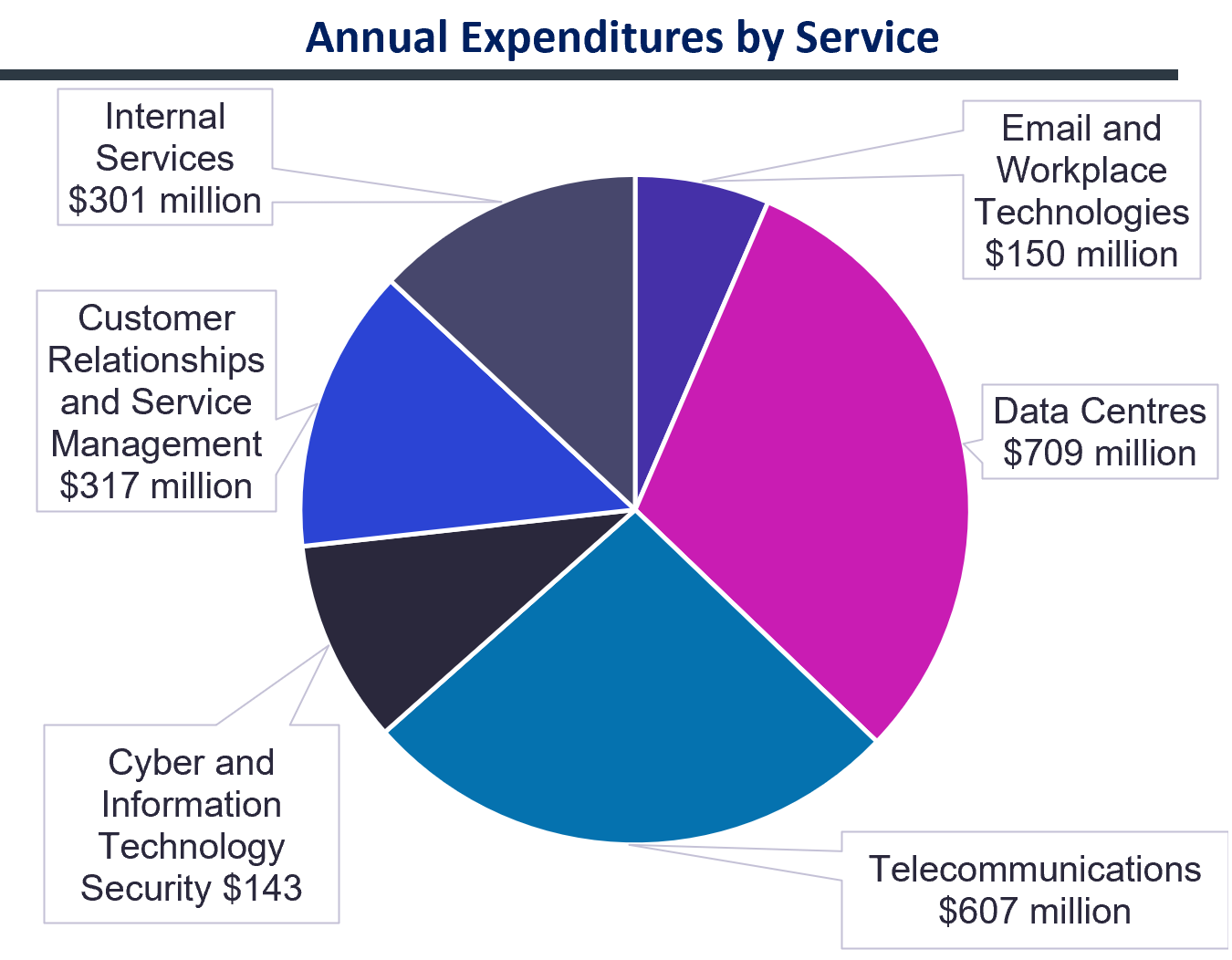 Click to enlarge
Click to enlarge
Image description – Annual expenditures by Service
- Internal Services $301 million
- Customer Relationships and Service Management $317 million
- Cyber and Information Technology Security $143 million
- Telecommunications $607 million
- Data Centres $709 million
- Email and Workplace Technologies$150 million
SSC Operations
- $1.4 billion SSC-led Project Costs
- $1.2 billion Tangible Capital Assets
- 3,174 Formal Business Requests
Source: Departmental Results Report 2020-21 - Canada.ca Government of Canada Enterprise Dashboard (May 2021) Budget of 2021-22 Main Estimates
Regional Distribution
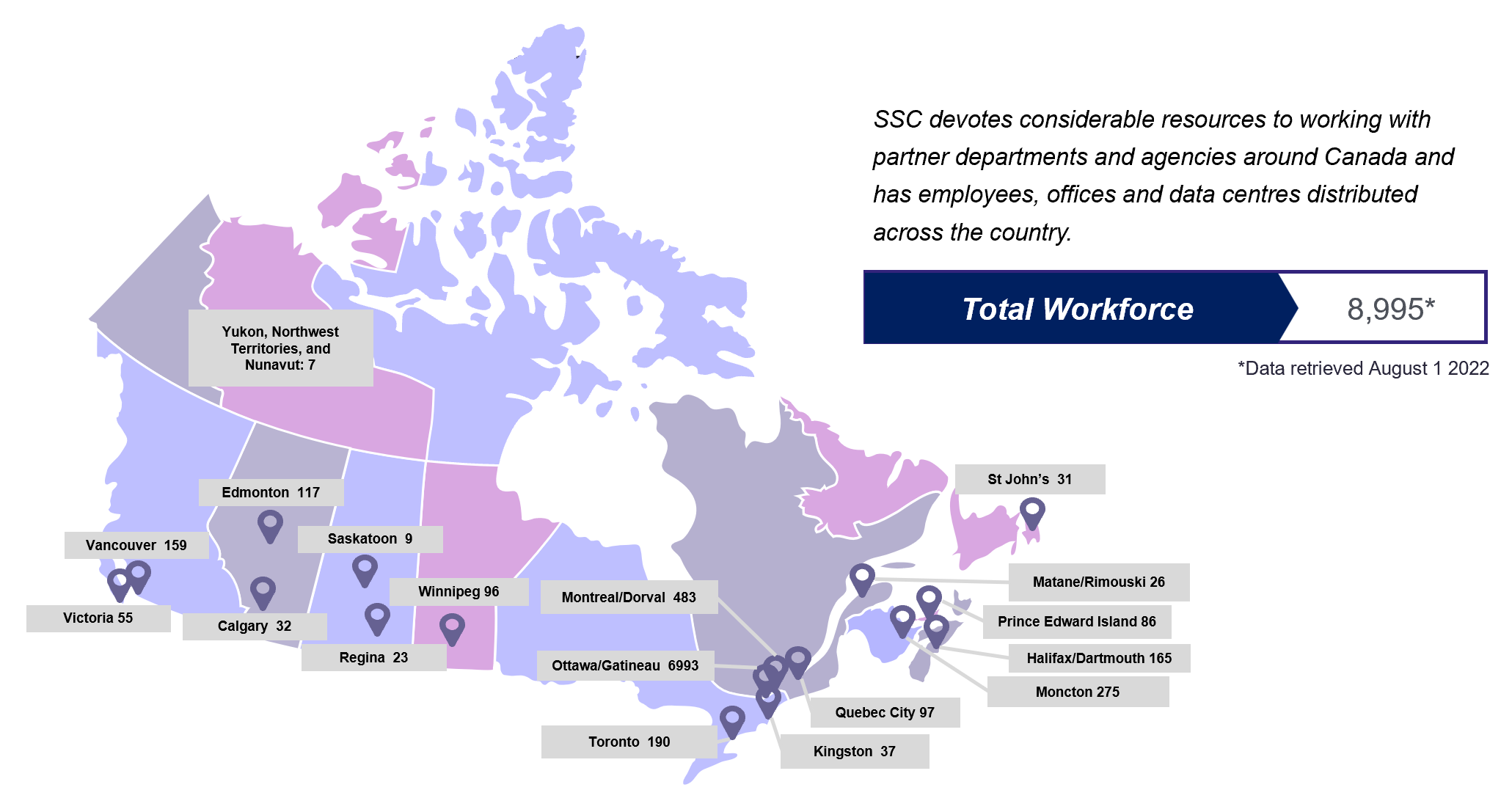 Click to enlarge
Click to enlarge
Image description – Regional distribution
SSC devotes considerable resources to working with partner departments and agencies around Canada and has employees, offices and data centres distributed across the country.
Total workforce 8,995 (Data retrieved August 1, 2022)
- Yukon, Northwest Territories, and Nunavut: 7
- Vancouver 159
- Victoria 55
- Edmonton 117
- Calgary 32
- Saskatoon 9
- Regina 23
- Winnipeg 96
- Montreal/Dorval 483
- Ottawa/Gatineau 6993
- Toronto 190
- Kingston 37
- Quebec City 97
- Moncton 275
- Halifax/Dartmouth 165
- Prince Edward Island 86
- Matane/Rimouski 26
- St John’s 31
Organizational Chart
President
Sonny Perron
Executive Vice-President
Scott Jones
- Senior Assistant Deputy Minister, Operations Management
Greg McKay - Assistant Deputy Minister, Networks and Security Services
Patrice Nadeau - Assistant Deputy Minister, Digital Services
Kristin Brunner - Assistant Deputy Minister, Data Centre Services
Jacquie Manchevsky - Senior Assistant Deputy Minister, Project Management and Delivery
Louis-Paul Normand - Assistant Deputy Minister, Project Management and Delivery (transition)
Nutan Behki - Assistant Deputy Minister, Next Generation HR and Pay
Shereen Benzvy Miller - Assistant Deputy Minister, Strategy and Engagement
Paule Labbé - Assistant Deputy Minister, Client Service Delivery and Management - Citizen and Business
Kristina Casey - Assistant Deputy Minister, Client Service Delivery and Management - National Defence and Policing
Brendan Dunn - Assistant Deputy Minister, Client Service Delivery and Management - Digital Government and Science
José Gendron - Assistant Deputy Minister, Enterprise Information Technology Procurement and Corporate Services
Robert Ianiro - Assistant Deputy Minister and Deputy Chief Technology Officer
Shannon Archibald - Chief Technology Officer
Matt Davies - Assistant Deputy Minister and Chief Financial Officer
Samantha Hazen - Chief Audit and Evaluation Executive
Begonia Lojk - Chief Information Officer
Marie-Claude Renaud - Ombuds
Alexandre St-Jean
SSC Fun Facts
Supercomputing
SSC supports Environment and Climate Change Canada High Performance Computing capacity to improve the accuracy and timeliness of weather forecasting services.
Satellite Communication
SSC supports the Department of National Defence’s ability to communicate with ships around the world via satellite network.
Canadarm2
SSC supported the Canadian Space Agency to ensure the success of robotics operations on board the International Space Station.
Annexes
Shared Services Canada Act
The Shared Services Canada Act, and Orders-in-Council, stipulates how Shared Services Canada supports the Government of Canada in its delivery of the many programs and services provided by numerous organizations to Canadians.
Shared Services Canada Act
- The Act establishes Shared Services Canada’s role to provide centralized administrative shared services to the Government of Canada.
- The Governor in Council may name the Minister responsible for Shared Services Canada, set out the specific mandated services and identify the departments that Shared Services Canada may and must serve through Orders‐in‐Council.
- The Act gives the Minister responsible for Shared Services Canada enabling procurement authorities.
Orders-in-Council
- Orders-in-Council outline Shared Services Canada’s core mandate with regards to the provision of services related to:
- email;
- data centres;
- networks; and,
- services related to end-user information technologies (also known as work place technology devices) with the exception of end-user support services.
- As part of these four mandate areas, Shared Services Canada also plays a significant cyber security role, in close collaboration with other security departments and agencies.
Annex: Shared Services Canada Partners (email, networks, and data centre services)
The following partners are mandatory recipients of Shared Services Canada email, networks, and data centre services, along with Shared Services Canada end-user information technology and workplace technology device services.
- Agriculture and Agri-Food Canada
- Atlantic Canada Opportunities Agency
- Canada Border Services Agency
- Canada Economic Development for Quebec Regions
- Canada Revenue Agency
- Canada School of Public Service
- Canadian Food Inspection Agency
- Canadian Heritage
- Canadian Northern Economic Development Agency
- Canadian Nuclear Safety Commission
- Canadian Space Agency
- Correctional Service of Canada
- Crown-Indigenous Relations and Northern Affairs Canada
- Department of Finance Canada
- Department of Justice Canada
- Employment and Social Development Canada
- Environment and Climate Change Canada
- Federal Economic Development Agency for Southern Ontario
- Financial Transactions and Reports Analysis Centre of Canada
- Fisheries and Oceans Canada
- Global Affairs Canada
- Health Canada
- Immigration and Refugee Board of Canada
- Immigration, Refugees and Citizenship Canada
- Indigenous Services Canada
- Infrastructure Canada
- Innovation, Science and Economic Development Canada
- Library and Archives Canada
- National Defence
- National Research Council
- Natural Resources Canada
- Pacific Economic Development Canada
- Parks Canada
- Prairies Economic Development Canada
- Privy Council Office
- Public Health Agency of Canada
- Public Safety Canada
- Public Service Commission
- Public Services and Procurement Canada
- Royal Canadian Mounted Police
- Shared Services Canada
- Statistics Canada
- Transport Canada
- Treasury Board of Canada Secretariat
- Veterans Affairs Canada
Since 2015, certain partners now conduct business under a new name without changing their official name (as it appears in the Financial Administration Act). Others have been dissolved and no longer exist. In the absence of an updated Order in Council, some newly created departments that assumed control over the IT assets of dissolved partner departments continue to be treated as partners by SSC.
Annex: Shared Services Canada Mandatory Clients (email, networks, and data centre services)
The following Government of Canada clients are mandatory recipients of a subset of Shared Services Canada email, networks, and data centre services, and are mandatory recipients of Shared Services Canada end-user information technology and workplace technology device services.
- Administrative Tribunals Support Service of Canada
- Canada Employment Insurance Commission
- Canada Energy Regulator
- Canadian Centre for Occupational Health and Safety
- Canadian Grain Commission
- Canadian Human Rights Commission
- Canadian Institutes of Health Research
- Canadian Intergovernmental Conference Secretariat
- Canadian Radio-television and Telecommunications Commission
- Canadian Security Intelligence Service
- Canadian Transportation Accident Investigation and Safety Board
- Canadian Transportation Agency
- Civilian Review and Complaints Commission for the RCMP
- Communications Security Establishment
- Copyright Board
- Federal Judicial Affairs Canada
- Financial Consumer Agency of Canada
- Impact Assessment Agency of Canada
- Invest in Canada Hub
- Military Grievances External Review Committee
- Military Police Complaints Commission of Canada
- National Film Board of Canada
- Natural Sciences and Engineering Research Council of Canada
- National Battlefields Commission
- National Farm Products Council
- Northern Pipeline Agency Canada
- Secretariat of the National Security and Intelligence Committee of Parliamentarians
- Office of the Communications Security Establishment Commissioner
- Office of the Correctional Investigator
- Office of the Secretary to the Governor General
- Office of the Superintendent of Financial Institutions
- Parole Board of Canada
- Patented Medicine Prices Review Board
- Polar Knowledge Canada
- Public Prosecution Service of Canada
- Royal Canadian Mounted Police External Review Committee
- Security Intelligence Review Committee
- Social Sciences and Humanities Research Council of Canada
- Veterans Review and Appeal Board
- Women and Gender Equality Canada
- Secretariat of the National Security and Intelligence Committee of Parliamentarians (Govt House Leader)
- Social Sciences and Humanities Research Council
- Veterans Review and Appeal Board
Annexe: SSC Mandatory Clients (end-user information technology and workplace technology device services)
The following GC clients are mandatory recipients of SSC end-user information technology and workplace technology device services. The number in parentheses refers to the Schedules to the Financial Administration Act where they are located (I, I.1 or II).
- Administrative Tribunals Support Service of Canada (I.1)
- D. Agriculture and Agri-Food (I)
- Atlantic Canada Opportunities Agency (I.1)
- Canada Border Services Agency (II)
- Canada Emission Reduction Incentives Agency (II)
- Canada Employment Insurance Commission (II)
- Canada Revenue Agency (II)
- Canada School of Public Service (II)
- Canadian Accessibility Standards Development Organization (II)
- Canadian Centre for Occupational Health and Safety (II)
- Canadian Energy Regulator (II)
- Canadian Food Inspection Agency (II)
- Canadian Grain Commission (I.1)
- D. Canadian Heritage (I)
- Canadian High Arctic Research Station (II)
- Canadian Human Rights Commission (I.1)
- Canadian Institutes of Health Research (II)
- Canadian Intergovernmental Conference Secretariat (I.1)
- Canadian Northern Economic Development Agency (I.1)
- Canadian Nuclear Safety Commission (II)
- Canadian Radio-television and Telecommunications Commission (I.1)
- Canadian Security Intelligence Service (I.1)
- Canadian Space Agency (I.1)
- Canadian Transportation Accident Investigation and Safety Board (II)
- Canadian Transportation Agency (I.1)
- D. Citizenship and Immigration (I)
- Civilian Review and Complaints Commission for the Royal Canadian Mounted Police (I.1)
- Communications Security Establishment (I.1)
- Copyright Board (I.1)
- Correctional Service of Canada (I.1)
- D. Crown-Indigenous Relations and Northern Affairs (I)
- Economic Development Agency of Canada for the Regions of Quebec (I.1)
- D. Employment and Social Development (I)
- D. the Environment (I)
- Federal Economic Development Agency for Northern Ontario (I.1)
- Federal Economic Development Agency for Southern Ontario (I.1)
- D. Finance (I)
- Financial Consumer Agency of Canada (I.1)
- Financial Transactions and Reports Analysis Centre of Canada (I.1)
- D. Fisheries and Oceans (I)
- D. Foreign Affairs, Trade and Development (I)
- D. Health (I)
- Immigration and Refugee Board (I.1)
- Impact Assessment Agency of Canada (I.1)
- D. Indigenous Services (I)
- D. Industry (I)
- Invest in Canada Hub (II)
- D. Justice (I)
- Law Commission of Canada (II)
- Leaders’ Debates Commission (I.1)
- Library and Archives of Canada (I.1)
- Military Grievances External Review Committee (I.1)
- Military Police Complaints Commission (I.1)
- The National Battlefields Commission (II)
- D. National Defence (I)
- National Farm Products Council (I.1)
- National Film Board (I.1)
- National Research Council of Canada (II)
- D. Natural Resources (I)
- Natural Sciences and Engineering Research Council (II)
- National Security and Intelligence Review Agency Secretariat (I.1)
- Northern Pipeline Agency (I.1)
- Office of Infrastructure of Canada (I.1)
- Office of the Commissioner for Federal Judicial Affairs (I.1)
- Office of the Correctional Investigator of Canada (I.1)
- Office of the Director of Public Prosecutions (I.1)
- Office of the Governor General’s Secretary (I.1)
- Office of the Intelligence Commissioner (I.1)
- Office of the Superintendent of Financial Institutions (I.1)
- Pacific Economic Development Agency of Canada (I.1)
- Parks Canada Agency (II)
- Parole Board of Canada (I.1)
- Patented Medicine Prices Review Board (I.1)
- Privy Council Office (I.1)
- Public Health Agency of Canada (I.1)
- D. Public Safety and Emergency Preparedness (I)
- Public Service Commission (I.1)
- D. Public Works and Government Services (I)
- Royal Canadian Mounted Police (I.1)
- Royal Canadian Mounted Police External Review Committee (I.1)
- Secretariat of the National Security and Intelligence Committee of Parliamentarians (I.1)
- Shared Services Canada (I.1)
- Social Sciences and Humanities Research Council (II)
- Statistics Canada (I.1)
- D. Transport (I)
- Treasury Board (I)
- D. Veterans Affairs (I)
- Veterans Review and Appeal Board (I.1)
- D. Western Economic Diversification (I)
- Department for Women and Gender Equality (I)
Annex: Shared Services Canada Optional Clients
The following Government of Canada clients are optional recipients of Shared Services Canada services.
- Atlantic Pilotage Authority
- Atomic Energy of Canada Limited
- Bank of Canada
- Business Development Bank of Canada
- Canada Council for the Arts
- Canada Deposit Insurance Corporation
- Canada Development Investment Corporation
- Canada Infrastructure Bank
- Canada Lands Company Limited
- Canada Mortgage and Housing Corporation
- Canada Pension Plan Investment Board
- Canadian Air Transport Security Authority
- Canadian Broadcasting Corporation
- Canadian Commercial Corporation
- Canadian Dairy Commission
- Canadian Museum for Human Rights
- Canadian Museum of History
- Canadian Museum of Immigration
- Canadian Museum of Nature
- Canada Post Corporation
- Canadian Race Relations Foundation
- Conflict of Interest and Ethics Commissioner
- Courts Administration Service
- Defence Construction Limited
- Destination Canada
- Export Development Canada
- Federal Bridge Corporation Limited
- Farm Credit Canada
- Freshwater Fish Marketing Corporation
- Great Lakes Pilotage Authority
- House of Commons
- International Development Research Centre
- Laurentian Pilotage Authority
- Library of Parliament
- Marine Atlantic Inc.
- National Arts Centre
- National Capital Commission
- National Gallery of Canada
- National Museum of Science and Technology
- Office of the Auditor General of Canada
- Office of The Chief Electoral Officer
- Office of the Commissioner of Lobbying
- Office of the Commissioner of Official Languages
- Offices of the Information and Privacy Commissioners of Canada
- Public-Private Partnerships Canada Inc.
- Pacific Pilotage Authority
- Parliamentary Protective Service
- Public Sector Integrity Commissioner
- Public Sector Pension Investment Board
- Registrar of the Supreme Court Of Canada
- Royal Canadian Mint
- Ridley Terminals Inc.
- Senate Ethics Officer
- Senate of Canada
- Standards Council of Canada
- Telefilm Canada
- The Jacques-Cartier and Champlain Bridges Inc.
- VIA Rail Canada
- Windsor-Detroit Bridge Authority
Page details
- Date modified: